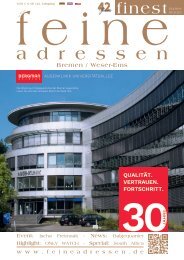»feine adressen – finest« – Edition Berlin/Potsdam I/2022
Create successful ePaper yourself
Turn your PDF publications into a flip-book with our unique Google optimized e-Paper software.
Risikofaktoren allesamt erkannt werden. Diese können<br />
in einem sog. Score (5) in ihren prognostischen Bedeutungen<br />
verrechnet werden und es entsteht ein prozentuales<br />
Gesamtrisiko eines zu erwartenden Herzinfarktes.<br />
Weiterhin können erste Veränderungen mit modernen diagnostischen<br />
Methoden wie moderner Bildgebung erkannt<br />
werden. Aus diesen Erkenntnissen erwächst dann eine personalisierte<br />
Beratung zum Lebensstil, teilweise auch schon<br />
Medikamenten oder Supplementierungen, die in belegter<br />
Weise die Prognose sehr gut verbessern können (5).<br />
In diesem Sinn: Bleiben Sie gesund und vital!<br />
Does a heart attack come out of the blue?<br />
by PROF DR UWE NIXDORFF<br />
The German Heart Foundation has been asking this question<br />
for years. Pretty much everyone knows someone who, with<br />
no warning symptoms <strong>–</strong> known as prodromes <strong>–</strong> has suddenly<br />
keeled over, dead. This tragic event is referred to as Sudden<br />
Cardiac Death, and is almost always the result of a heart<br />
attack. So, the question asked above is answered and this article<br />
is complete.<br />
But no … because unless you know there is a problem, you<br />
can’t do anything about it; that is, when you know something<br />
is wrong you can instigate preventative measures so as<br />
to improve both the quality and the length of your life. After<br />
all, we don’t want to be like Jim Fixx, an ambitious marathon<br />
runner in the 1960s who was instrumental in the development<br />
of the city marathon, and who dropped dead while running at<br />
the age of 56. Ironically his coronary arteries were filled with<br />
cholesterol deposits, or plaques.<br />
The dilemma becomes even more apparent if we look at what is<br />
known as the Rose paradox in epidemiology (1). Although it<br />
is easy to understand the correlation between the rate of sudden<br />
cardiac death and the degree of severity of a heart condition, if<br />
the absolute rate of sudden cardiac death is taken into account,<br />
the majority of people are not “qualified” by a previous heart<br />
condition. It is, instead, the entire “unremarkable” population<br />
who can be suddenly affected. When it comes to preventative<br />
medicine, it can no longer be an issue of medical attention being<br />
The pathophysiological<br />
history, that is the background<br />
that can be explained<br />
by the pathology, of atherosclerosis<br />
(thickening and tion of the vascular wall) has been<br />
calcifica-<br />
well understood for some 20 years.<br />
It is, in fact, a silent inflammation<br />
of the body (2), which is induced by<br />
being overweight, lack of exercise, and<br />
smoking, as well as traditional risk factors<br />
such as high blood pressure, diabetes mellitus<br />
and, in particular, lipometabolic disorders with elevated<br />
LDL (“bad”) cholesterol. Atherosclerotic plaques develop, but<br />
initially these do not block the blood flow because at this stage<br />
they are flat.<br />
These people <strong>–</strong> we are not even talking about patients <strong>–</strong> do<br />
not become symptomatic, and the problem is extremely hard<br />
to detect in normal medical examinations; perhaps only with<br />
direct imaging such as a CT (3). Then suddenly <strong>–</strong> out of the<br />
blue <strong>–</strong> a rupture can occur; caused, for example, by acute stress<br />
or a blood pressure crisis. This has the same effect on the coagulation<br />
system as an acute external injury. While the latter is<br />
good, because clot formation closes and heals the wound, a clot<br />
inside a vessel is bad, because it closes the vessel. If this happens<br />
in the coronary artery, there is no longer a blood supply<br />
to the heart muscle and this leads to a sudden heart attack (4).<br />
given only to<br />
symptomatic<br />
people.<br />
The only possible conclusion to be drawn by these findings is<br />
that people should not wait for symptoms, which are often fatal<br />
the first time they appear. It is essential that all cardiovascular<br />
risk factors are recognised. A score (5) can be used to calculate<br />
the prognostic significance of each factor and determine the<br />
total percentage risk of a heart attack occurring. State-of-the-art<br />
diagnostic methods such as modern imaging can also be used to<br />
detect early changes. The findings can be followed by personal<br />
lifestyle counselling and, in some cases, also by medication or<br />
supplements, which have been proven to greatly improve the<br />
prognosis (5)<br />
Referenzen<br />
1. Huikuri HV, Castellanos A, Myerburg RJ. Sudden death due to cardiac arrhythmias. N Engl J Med 2001; 345:1473-82<br />
2. Libby P, Ridker P, Maseri A. Inflammation and atherosclerosis. Circulation 2002; 105:1135-43<br />
3. Nixdorff U, Achenbach S, Bengel F, et al. Imaging in cardiovascular prevention. The ESC Textbook of Preventive Cardiology. Oxford Press 2016; pp 54-76<br />
4. Naghavi M, Libby P, Falk E, et al. From vulnerable plaque to vulnerable patient: a call for new definitions and risk assessment strategies: Part I. Circulation 2003; 108:1664-72<br />
5. Visseren FLJ, Mach F, Smulders YM, et al. 2021 ESC Guidelines on cardiovascular disease prevention in clinical practice. Eur Heart J 2021; 42:3237-337


















